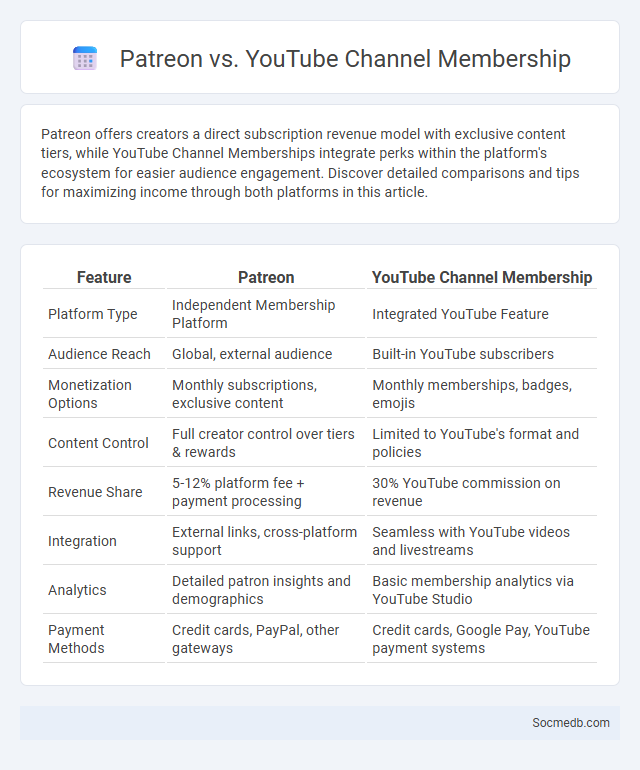
Photo illustration: Patreon vs YouTube Channel Membership
Patreon offers creators a direct subscription revenue model with exclusive content tiers, while YouTube Channel Memberships integrate perks within the platform's ecosystem for easier audience engagement. Discover detailed comparisons and tips for maximizing income through both platforms in this article.
Table of Comparison
| Feature | Patreon | YouTube Channel Membership |
|---|---|---|
| Platform Type | Independent Membership Platform | Integrated YouTube Feature |
| Audience Reach | Global, external audience | Built-in YouTube subscribers |
| Monetization Options | Monthly subscriptions, exclusive content | Monthly memberships, badges, emojis |
| Content Control | Full creator control over tiers & rewards | Limited to YouTube's format and policies |
| Revenue Share | 5-12% platform fee + payment processing | 30% YouTube commission on revenue |
| Integration | External links, cross-platform support | Seamless with YouTube videos and livestreams |
| Analytics | Detailed patron insights and demographics | Basic membership analytics via YouTube Studio |
| Payment Methods | Credit cards, PayPal, other gateways | Credit cards, Google Pay, YouTube payment systems |
Overview of Patreon, YouTube Channel Membership, and Channel Membership
Patreon empowers creators by offering subscription-based support, enabling fans to fund content through tiered memberships with exclusive perks. YouTube Channel Membership provides a similar model within the platform, granting subscribers access to badges, emojis, and members-only videos to enhance engagement. Your choice between Patreon and YouTube Channel Membership depends on the level of control you want over membership tiers, payment processing, and content accessibility.
Key Features Comparison
Social media platforms vary widely in their core functionalities, with Facebook offering robust community engagement tools such as groups and events, while Instagram specializes in visual storytelling through images and short videos. Twitter emphasizes real-time updates and concise communication with its character-limited posts, whereas LinkedIn focuses on professional networking and career development resources. TikTok stands out for its algorithm-driven short-form video content that boosts viral potential and user interaction.
Monetization Options and Revenue Models
Social media platforms offer diverse monetization options including advertising revenue, sponsored posts, subscription models, and affiliate marketing. Influencers and content creators leverage brand partnerships and paid endorsements to generate income. Platforms like YouTube, Instagram, and TikTok utilize revenue-sharing models, combining ad placements and premium content access for sustainable earnings.
Audience Engagement and Community Tools
Social media platforms offer powerful audience engagement features such as interactive polls, live streaming, and real-time comments that foster deeper connections and immediate feedback. Community tools like groups, forums, and event pages enable users to collaborate, share interests, and build loyal networks around shared topics and brands. Leveraging these features boosts user retention and enhances brand visibility through authentic communication and user-generated content.
Pricing and Membership Tiers
Social media platforms offer a variety of pricing models and membership tiers tailored to different user needs, ranging from free basic access to premium subscriptions with advanced features such as analytics, ad-free browsing, and exclusive content. You can choose plans that support personal use, small businesses, or enterprise-level marketing campaigns, with costs varying widely based on the level of service and additional tools provided. Understanding these tiers helps maximize your social media investment by aligning features like audience insights, scheduling capabilities, and customer support with your specific goals.
Platform Fees and Payout Structures
Social media platforms typically implement platform fees ranging from 10% to 30% on transactions, impacting creators' earnings from monetized content or e-commerce sales. Payout structures vary widely, with some platforms offering daily or weekly payments while others operate on a monthly cycle, influencing cash flow and financial planning for users. Understanding the specific fee percentages and payout schedules of platforms like YouTube, Instagram, and TikTok is crucial for maximizing revenue on social media.
Customization and Branding Opportunities
Social media platforms offer extensive customization options that allow you to tailor your profiles and content to reflect your unique brand identity. By leveraging features like custom logos, color schemes, and personalized bios, your presence becomes more memorable and engaging to your target audience. Utilizing branding opportunities effectively boosts recognition and fosters stronger connections with potential customers.
Content Delivery and Exclusivity
Maximizing your social media impact requires strategic content delivery tailored to your audience's preferences and engagement patterns. Leveraging exclusive content such as behind-the-scenes footage, limited-time offers, and member-only access enhances your brand's perceived value and encourages loyal followership. Prioritizing platform-specific formats like Instagram Stories, TikTok videos, or LinkedIn articles ensures your message reaches the right users efficiently and effectively.
Analytics, Insights, and Growth Tools
Social media analytics tools gather data on user engagement, reach, and demographics to provide actionable insights for optimizing content strategies. Advanced growth tools leverage these insights to target audiences effectively, increase follower count, and enhance campaign performance. Platforms like Facebook Insights, Instagram Analytics, and Twitter Analytics offer robust features to track metrics and drive measurable social media growth.
Pros, Cons, and Best Use Cases
Social media platforms enhance communication by enabling instant connectivity, diverse content sharing, and targeted marketing strategies for businesses. However, they pose risks such as misinformation spread, privacy breaches, and potential mental health impacts from excessive use. Best use cases include brand promotion, community building, customer engagement, and real-time information dissemination during events or crises.
 socmedb.com
socmedb.com